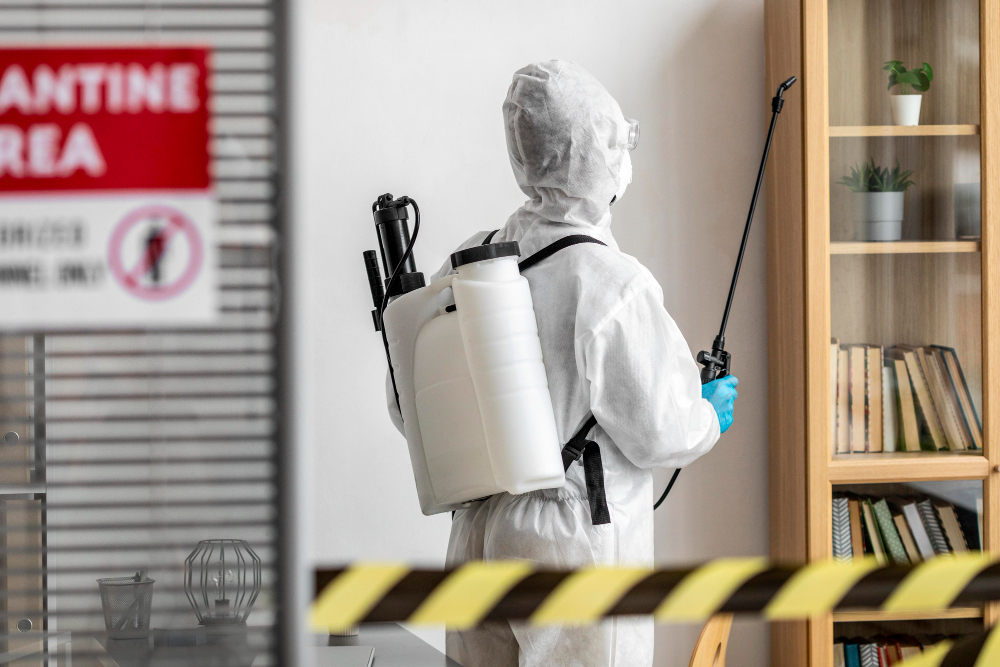Introduction
The Importance of an Effective Call-to-Action in Pest Control Ads
A well-crafted call-to-action (CTA) is the backbone of any successful pest control advertisement. It’s the final nudge that encourages potential customers to take action, whether it’s contacting your company, scheduling an inspection, or signing up for a service. Without a strong CTA, even the most informative and visually appealing ad can fall flat. In the highly competitive pest control industry, your CTA needs to be clear, concise, and tailored to resonate with your Ideal Pest Control Customer.
An effective CTA goes beyond a simple “Call Now” or “Get Started.” It should align with the needs and concerns of your target audience. Pest control customers are often driven by urgency—whether they’re facing an infestation or simply looking for preventive services, your CTA must tap into that immediate need. By understanding your audience’s pain points, you can craft a CTA that speaks directly to their situation, prompting them to act quickly and decisively.
Understanding the Ideal Pest Control Customer
To create a compelling CTA, you must first understand your Ideal Pest Control Customer. This involves identifying the specific characteristics, behaviors, and needs of the people most likely to use your services. For example, your ideal customer might be a homeowner dealing with recurring pest problems, or perhaps a business owner concerned about maintaining a pest-free environment for customers.
Knowing who your ideal customer is allows you to tailor your CTA to address their concerns directly. Are they worried about the safety of pest control treatments around pets and children? Emphasize safety and eco-friendly solutions in your CTA. Are they seeking fast, effective results? Highlight your company’s quick response time and proven methods. By pinpointing what motivates your audience, you can craft a CTA that feels personalized, making it far more effective in driving conversions.
Identifying Your Ideal Pest Control Customer

Defining Demographics and Pain Points
To craft a call-to-action that resonates, it’s essential to first define the demographics and pain points of your Ideal Pest Control Customer. Demographics are key details like age, location, income level, and home ownership status. For pest control, your target demographic often includes homeowners, renters, and business owners within specific areas who are experiencing pest issues. Defining these basic details allows you to focus your ad on the audience most likely to need your services.
Beyond demographics, pain points are crucial in understanding what motivates your ideal customer. Pest control customers often experience urgent concerns, such as dealing with an infestation, protecting their families, or maintaining a clean business environment. Other common pain points include safety concerns with pesticides, affordability of services, and the desire for effective, long-lasting solutions. By knowing these motivations, you can create a CTA that speaks directly to these needs, offering reassurance and a clear path to solving their problem.
How to Research Your Ideal Pest Control Customer
Researching your Ideal Pest Control Customer involves both quantitative and qualitative approaches. Start with data collection from customer records, surveys, or industry reports to identify common characteristics among your customer base. Social media platforms and online forums, such as Reddit and neighborhood groups, are also valuable for understanding specific pest issues affecting different regions and for finding out what customers truly care about in a pest control service.
Another effective approach is to analyze competitors’ customer reviews. Look for common themes in reviews where customers highlight positive experiences or express frustrations. These insights can reveal key details about what your ideal customer values most and what they’re looking for in a service. By combining demographic data and an in-depth understanding of pain points, you can create a call-to-action that resonates with your ideal audience, increasing engagement and driving conversions.
Aligning Your Call-to-Action with Customer Needs

Crafting CTAs That Resonate with Your Ideal Pest Control Customer
Crafting effective calls-to-action (CTAs) is essential for connecting with your Ideal Pest Control Customer. To resonate with this audience, your CTAs should reflect an understanding of their specific needs and concerns. Instead of generic phrases, tailor your language to directly address what motivates your ideal customers.
For instance, if your research indicates that your target audience is primarily concerned about quick pest removal, consider CTAs like “Eliminate Pests Today!” or “Get Fast Relief from Infestations!” These phrases communicate urgency and action, appealing to those who need immediate solutions. Additionally, using relatable language that reflects the customer’s situation, such as “Protect Your Home from Pests Now,” can create a sense of urgency while making your message more personal and compelling.
Including a sense of exclusivity can also enhance your CTAs. Phrases like “Join Our Pest-Free Community Today” not only encourage action but also foster a sense of belonging and assurance that they are making the right choice.
Addressing Pain Points with Action-Oriented Language
Addressing pain points with action-oriented language is crucial when crafting your CTAs. Understanding the specific fears and frustrations of your Ideal Pest Control Customer allows you to tailor your messaging effectively. For example, many homeowners worry about the health risks associated with pest control treatments. By incorporating action-oriented language that addresses these concerns, you can create CTAs that alleviate fears while encouraging action. Phrases such as “Safe and Effective Pest Control Solutions—Book Your Service Today!” can ease concerns while prompting potential customers to take the next step.
Another common pain point is the cost associated with pest control services. Use your CTAs to highlight affordable options and promotions, such as “Affordable Pest Control Plans Available—Contact Us for a Free Quote!” This not only emphasizes value but also encourages immediate engagement, helping potential customers feel more at ease with their decision to reach out.
By focusing on the pain points of your ideal audience and employing action-oriented language, you create CTAs that resonate deeply with your Ideal Pest Control Customer. This approach not only drives immediate responses but also establishes trust and credibility for your pest control services.
Examples of Effective CTAs for Pest Control Ads

How to Target the Ideal Pest Control Customer Through Your CTA
Targeting your Ideal Pest Control Customer through your call-to-action (CTA) requires a strategic approach that aligns with their specific needs and motivations. Start by identifying the channels where your ideal customers are most active, whether it’s social media, email marketing, or your website. Tailoring your CTAs to the platform can enhance their effectiveness. For example, a more casual and engaging CTA may work better on social media, while a direct and informative approach might be more suitable for email marketing.
Next, ensure that your CTAs are not only appealing but also relevant to the context in which they appear. For instance, if a potential customer is reading about the dangers of pests in their home, a CTA like “Schedule Your Free Pest Inspection Today!” speaks directly to their immediate concerns. The more your CTA aligns with the content and context that your ideal customer is engaging with, the more likely they are to respond positively.
Finally, consider personalizing your CTAs based on user behavior. If a customer has previously visited your website and shown interest in specific services, a follow-up CTA like “Don’t Let Pests Take Over—Get 20% Off Your First Service!” can create a sense of urgency and exclusivity, encouraging them to take action. By understanding your audience and delivering targeted CTAs that resonate with their specific situation, you can significantly enhance your ad’s effectiveness.
Successful CTA Phrases That Drive Conversions
Using successful CTA phrases is key to driving conversions among your Ideal Pest Control Customer. Here are some examples of effective phrases that you can incorporate into your ads:
- “Act Now to Protect Your Home from Pests!”
This phrase creates a sense of urgency while emphasizing the importance of immediate action. - “Get a Free Pest Control Quote Today!”
Offering a free quote reduces the risk for potential customers and encourages them to engage without financial commitment. - “Join Our Happy Customers—Book Your Service Today!”
This phrase not only calls for action but also leverages social proof, making prospects feel more confident in their choice. - “Limited Time Offer: Save 15% on Your First Treatment!”
Highlighting a time-sensitive discount can motivate customers to act quickly, ensuring they don’t miss out on savings. - “Say Goodbye to Pests—Schedule Your Inspection Now!”
This CTA directly addresses the customer’s desire for a pest-free home and prompts immediate action. - “Don’t Wait Until It’s Too Late—Contact Us for a Free Consultation!”
This phrase appeals to the urgency of dealing with pest problems while encouraging potential customers to reach out.
By utilizing these successful CTA phrases, you can effectively target your Ideal Pest Control Customer and increase the likelihood of conversions. Remember to continuously test and refine your CTAs based on customer responses and engagement rates to ensure you are meeting their needs effectively.
Testing and Optimizing Your Call-to-Action

A/B Testing CTAs to Appeal to the Ideal Pest Control Customer
A/B testing, or split testing, is a powerful method to optimize your call-to-action (CTA) and ensure it resonates with your Ideal Pest Control Customer. This technique involves creating two versions of a CTA—Version A and Version B—to see which one performs better in terms of engagement and conversion rates. By making slight modifications to wording, design, color, or placement, you can gather valuable insights into what appeals most to your target audience.
When conducting A/B tests, it’s crucial to isolate one variable at a time. For example, you might test two different phrases, such as “Schedule Your Free Inspection Today!” versus “Get Your Free Pest Assessment Now!” By monitoring the performance of each version over a defined period, you can determine which CTA drives more clicks and conversions. Ensure that your sample size is large enough to yield statistically significant results, allowing you to draw reliable conclusions.
Additionally, consider the context in which the CTAs are displayed. Testing CTAs on different platforms—like social media, email newsletters, and landing pages—can provide further insights into where your Ideal Pest Control Customer is most responsive. The data collected from A/B testing will guide you in refining your messaging and optimizing your CTAs for maximum impact.
Analyzing Results and Making Data-Driven Adjustments
Once you’ve conducted A/B testing on your CTAs, the next step is analyzing the results to make informed, data-driven adjustments. Start by reviewing key performance metrics, such as click-through rates (CTR), conversion rates, and customer engagement levels. These metrics will provide a clear picture of how well each CTA performed.
Identify patterns and trends in the data. Did one phrase outperform another? Did a specific design or color scheme lead to higher engagement? Understanding these elements will help you tailor your CTAs more effectively to meet the needs of your Ideal Pest Control Customer.
After analyzing the results, implement the winning CTA across your marketing channels while continuing to monitor its performance. Remember that customer preferences can change over time, so it’s essential to maintain an ongoing testing and analysis strategy. Regularly revisiting your CTAs ensures they remain relevant and effective in driving conversions.
In summary, A/B testing and careful analysis of results empower you to create compelling CTAs that appeal to your Ideal Pest Control Customer. By making data-driven adjustments, you can continually refine your messaging, leading to improved engagement and conversion rates in your pest control ads.
Conclusion
Creating CTAs That Speak Directly to Your Ideal Pest Control Customer
Crafting CTAs that resonate with your Ideal Pest Control Customer involves a deep understanding of their needs, preferences, and pain points. To effectively connect with this audience, your CTAs should incorporate language and messaging that speaks directly to their unique circumstances.
Start by using action-oriented language that compels immediate response. Phrases like “Protect Your Home Today!” or “Schedule Your Free Inspection Now!” emphasize urgency and benefit, encouraging potential customers to take swift action. Additionally, using inclusive language that fosters a sense of community can also resonate well. Consider CTAs like “Join Thousands of Satisfied Customers!” which not only builds trust but also implies a shared experience among peers.
It’s also crucial to tailor your CTAs to specific situations. For example, if you’re targeting customers dealing with seasonal pest problems, a CTA like “Prepare for Spring—Get Your Pest Control Plan Today!” directly addresses their current needs. Incorporating personalization, such as using the customer’s name or localizing the message, can further enhance engagement. The more your CTAs reflect the specific concerns and desires of your Ideal Pest Control Customer, the more likely they will be to respond positively.
Final Thoughts on Enhancing Your Pest Control Ads with Strong CTAs
In conclusion, strong CTAs are integral to the success of your pest control ads. By focusing on your Ideal Pest Control Customer and crafting messages that resonate with their specific needs, you can create compelling CTAs that drive engagement and conversions. Remember that clarity is key; your customers should immediately understand what action you want them to take and the benefits they’ll receive from it.
Continually test and refine your CTAs based on customer feedback and performance metrics to ensure they remain relevant and effective. By embracing a customer-centric approach and incorporating data-driven strategies, you can enhance the overall effectiveness of your pest control ads.
With well-crafted CTAs, you not only capture attention but also motivate potential customers to take action, ultimately leading to increased inquiries and sales. Take the time to invest in creating strong, persuasive CTAs, and watch as your pest control business flourishes in a competitive market.
Author


